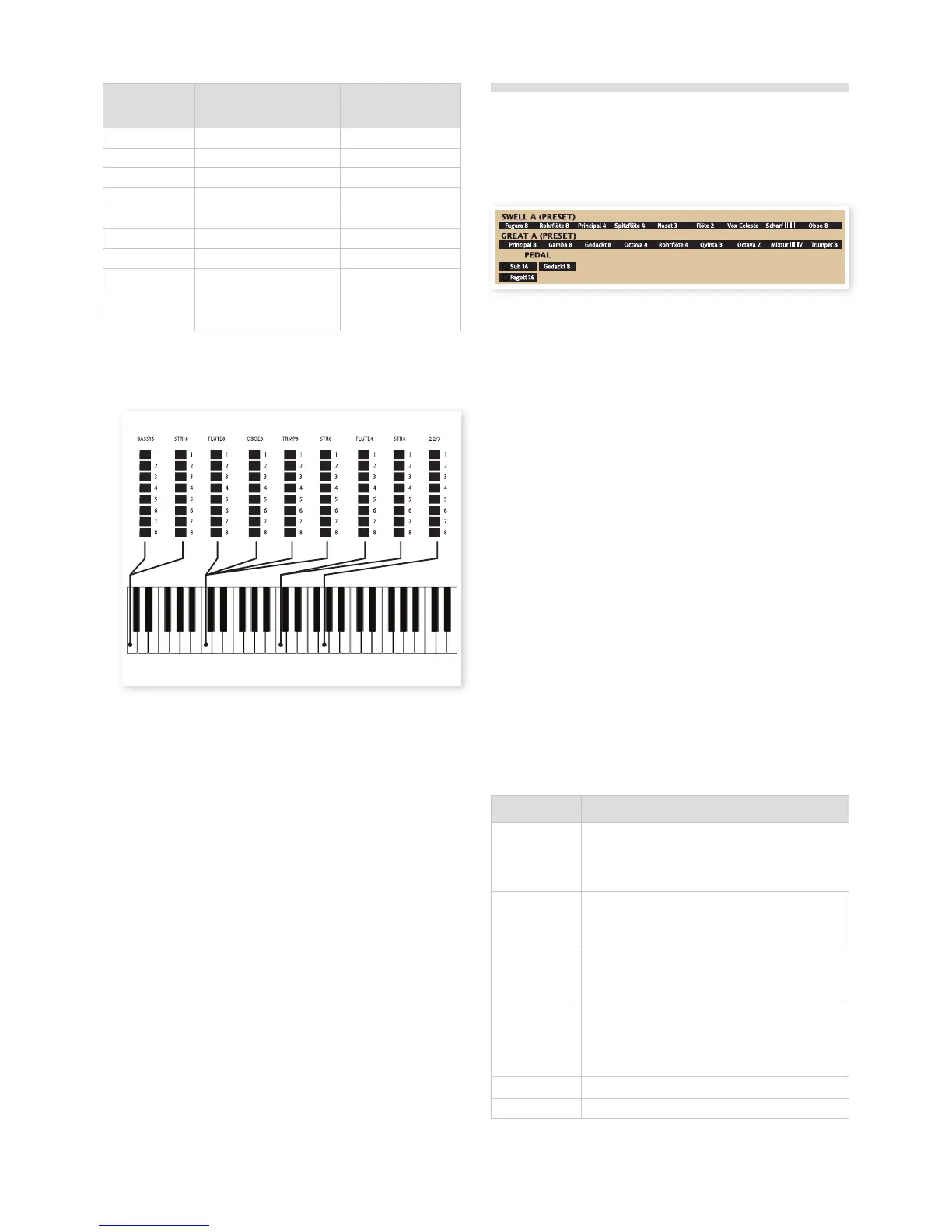Chapter 5 Nord C2d refereNCe | 15
Register
Selector
Voice Panel Name
1 Bass 16 BASS16
2 Strings 16 STR16
3 Flute 8 FLUTE8
4 Oboe 8 OBOE8
5 Trumpet 8 TRMP8
6 Strings 8 STR8
7 Flute 4 FLUTE4
8 Strings 4 STR4
9 A bright voice, an octave
and a fifth above the
fundamental
2 2/3
The illustration below shows the pitch interval between each voice
when the key of C3 is played. Though some voices have the same
pitch, they differ in tonal character.
Farf Vibrato
The original instrument have two basic vibrato modes; “Light” and
“Heavy”, with different rates for each mode. There are several types of
vibrato and choruses available for the Farf model in the C2D, which are
activated using the On button in the Vibrato section.
M The V1, V2 and the V3 settings are the ones that are modeled
after the original instrument.
M The Farf models vibrato setting is common for both the swell and
great manuals.
The Pipe Organ
The pipe organ model is a sampled classic organ with a set of pipes of
the baroque variety. The drawbars on the C2D acts as “stops” and the
description of the stops are above the drawbars. A stop can be on or
off, similar to the register selectors in the Farfisa model.
The two manuals have 9 different stops each. Their names are printed
on the panel above the drawbars. The pedals have 3 stops, the Fagot
16 can be added to the Sub stop by pulling down the drawbar a bit
further.
M When the pipe organ is selected, the speaker models, the sustain
pedal and the drive function will be inactive.
Pipe Organ Tremulant
When the pipe organ is selected, the vibrato/chorus function acts like
the tremulant of the original instrument. This functionality is achieved
by varying the actual wind supply to the pipes on a pipe organ. The
tremulants in the C2D can be activated individually for the swell and
the great manuals. You select which one to use by pressing the Vibrato
Mode button. The tremulant has two rates (V and C) with three depths
each (1, 2 & 3).
Press and hold Shift to cycle through the tremulant settings in a
counter-clockwise fashion.
M The bass stops are not affected by the tremulant.
The Couplers
When the pipe organ is used, the controls on the panel for the Rotary
speed and the Percussion controls are used to activate the pipe organ
couplers. A coupler allows the stops of one division or manual to be
played from another manual. This can be used to create huge sounds,
combinations of stops across the manuals and also to use the pedal
stops in combination with the two manual’s stops.
Coupler Description
PED/GR LOW This couples the lowest key played on the great
manual to the bass stop. The affected range ends
at F3. This is a great way to move some serious air
even if you do not have a set of pedals.
SW 16/GR This couples the stops on the swell manual to be
played on the great manual. The stops are also
transposed one octave down.
SW/GR This couples the stops on the swell manual to be
played on the great manual without any transposi-
tion.
SWELL 16 This doubles the stops on the swell manual, with
the doubling transposed one octave down.
SWELL 4 This doubles the stops on the swell manual, with
the doubling transposed one octave up.
SW/PED This couples the swell manual stops to the pedals.
GR/PED This couples the great manual stops to the pedals.
Upper & Lower
C3

